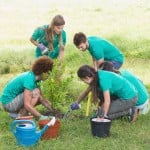The latest green architecture urbanism movement is changing our world for the better; here’s what it means and how you can get involved!
What Is ‘New Urbanism’?
 New Urbanism arose in the early 1980’s and revolves around creating walk-able, family-friendly neighborhoods with a convenient mix of housing and businesses. New urbanism has impacted many aspects of urban planning, real estate development and land-usage strategies.
New Urbanism arose in the early 1980’s and revolves around creating walk-able, family-friendly neighborhoods with a convenient mix of housing and businesses. New urbanism has impacted many aspects of urban planning, real estate development and land-usage strategies.
We have learned a lot since the 1980’s, and the newest ‘green urbanism’ has already begun to take off. While walk-able neighborhoods are nice, green neighborhoods are even nicer. According to the research, crime levels and even domestic disputes decrease when a neighborhood has more greenery. Simultaneously, community moral goes up.
It’s not just about planting more flowers and trees. The green urbanism movement is largely involved in creating sustainable landscaping and buildings that future generations can enjoy without repercussions. Not to mention, it also improves urban health.
What Is Urban Health?
 ‘Urban Health’ is defined as “the explicit investigation of the relation between the urban context and population distribution of health and disease.” A question someone involved with urban health might ask: Do more people fall ill (mentally or physically) living in urban cities filled with greenery, or in cities lacking greenery?
‘Urban Health’ is defined as “the explicit investigation of the relation between the urban context and population distribution of health and disease.” A question someone involved with urban health might ask: Do more people fall ill (mentally or physically) living in urban cities filled with greenery, or in cities lacking greenery?
The goal is to definitively prove that added greenery improves public health and overall quality of life, as it becomes much easier to implement policies that mandate the green urbanism movement.
The sanitary movement was established back in the 1840’s, after John Snow discovered a water pump caused a cholera outbreak in England. Today, we have far more to worry about than just contaminated water pumps.
Industrialization, air pollution and even noise pollution are huge causes for concern in all large US cities. This is directly related to the ways in which we handle city planning, as well as the manufacturing of the materials needed to build and landscape. We have become our own biggest enemies, but it’s not too late for that to change.
By switching to a more eco friendly way of building, landscaping and planning we could revert back to a cleaner existence. If we do not give credit to the green urbanism movement, things will only get worse, forcing children of the future to wear gas masks if they want to step outside.
How To Join The Green Urbanism Movement
1. Read Up On LEED
LEED is short for Leadership in Energy & Environmental Design. This non-profit internationally recognized program was created and remains maintained by the U.S. Green Building Council, USGBC.
The purpose of LEED Certification is to recognize and reward businesses using greener building practices. Depending on the type of project you are working on, there are 5 different rating systems. Projects are classified into one of 4 certification levels depending on how many ‘green’ points it earns when assessed by a third party.
Builders, engineers, planners, cities, municipalities, projects, architects and designers may obtain LEED Certification by using approved eco-friendly practices and materials.
Learn more about LEED Certification here: www.usgbc.org
 2. Plant More Trees
2. Plant More Trees
No matter what project you are working on, you can always incorporate more greenery. Inside or outside, it doesn’t matter where you are; greenery is always a welcoming sight. Not to mention, additional greenery helps promote better health and overall happiness. There’s nowhere that trees are off-limits, even a rooftop can be transformed into a lush garden.
3. Spread the Word
Once you are onboard with the basic underlying principles of green urbanism, spread the word with your friends, family and business relations. People may not even know or realize the impact they have on the planet. Yet, once alerted to the issues and solutions, one is far more likely to jump on board the green train as well. The more people vying for a greener tomorrow, the better off this planet will be 5, 10, even 50-years from now.
4. Think Sustainability
Ask yourself: where do the materials used for a project come from? Are they draining non-renewable or fragile renewable resources? These are important questions to ask unless you want to support unfair practices that harm real people, as well as the planet at large.
Join the green movement by using sustainable products that support American jobs, and are made with recycled materials meant to last for many years.
TerraCast Products are made with the green urban movement in mind, which is why so many LEED Certified projects rely on our planters, lighting fixtures, benches, receptacles and more.
Proof Green Urbanism Is Growing Stronger
 The great thing about the green urbanism movement is that it not only benefits the planet, but it benefits you and the overall project at hand. For instance, green building and landscaping projects last longer, require less maintenance and are more cost-effective over the long haul.
The great thing about the green urbanism movement is that it not only benefits the planet, but it benefits you and the overall project at hand. For instance, green building and landscaping projects last longer, require less maintenance and are more cost-effective over the long haul.
More and more books are being published on the changes impacting traditional landscaping, city planning and building practices. For instance, Leigh Gallagher’s book “The End of the Suburbs,” forces readers to imagine a world where a cul-de-sac is not the norm. And, “Garden Cities: Theory & Practice of Agrarian Urbanism,” by US urbanist Andrés Duany, focuses on creating community plans that combine agriculture and modern society in new, yet old-school ways. For instance, growing more community gardens so that people have the chance to grow some of their food and reduce pressures on industrial farming.
Architecture and design schools are heavily focusing on green building design, sustainable ways to accomplish building goals and how to become LEED certified. With so much political pull forming behind the green urbanism movement it’s a clear sign that the cities, businesses and residential communities of the future will look a lot different than they do today.
Join TerraCast in becoming a part of the future by adhering to greener standards! Learn more here: https://www.terracastproducts.com/environmentally-safe/
Sources: AIA, Places Journal

